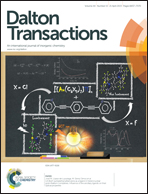Synthesis and characterization of [(CH3)2NH2][Na0.5Cr0.5(HCOO)3]: a rare example of luminescent metal–organic frameworks based on Cr(iii) ions†
Abstract
A novel formate [(CH3)2NH2][Na0.5Cr0.5(HCOO)3] (DMNaCr) was prepared by a solvothermal method. This compound crystallizes in the perovskite-type metal formate framework (space group R![[3 with combining macron]](https://www.rsc.org/images/entities/char_0033_0304.gif) ) with disordered dimethylammonium (DMA+) cations. X-ray diffraction, DSC, Raman and IR studies show that in contrast to the isostructural iron analogue [(CH3)2NH2][Na0.5Fe0.5(HCOO)3] (DMNaFe), DMNaCr does not exhibit any structural phase transition at low temperatures. This behavior has been attributed to the smaller flexibility of the perovskite-like framework in DMNaCr when compared with that of DMNaFe. Dielectric permittivity data reveal pronounced dielectric relaxation that is attributed to the dynamical rotation of DMA+ ions. Electron absorption and photoluminescence studies show that this material exhibits efficient emission at low temperatures. A detailed analysis of the optical properties shows that chromium ions are located at the site of intermediate crystal field strength with Dq/B = 2.29.
) with disordered dimethylammonium (DMA+) cations. X-ray diffraction, DSC, Raman and IR studies show that in contrast to the isostructural iron analogue [(CH3)2NH2][Na0.5Fe0.5(HCOO)3] (DMNaFe), DMNaCr does not exhibit any structural phase transition at low temperatures. This behavior has been attributed to the smaller flexibility of the perovskite-like framework in DMNaCr when compared with that of DMNaFe. Dielectric permittivity data reveal pronounced dielectric relaxation that is attributed to the dynamical rotation of DMA+ ions. Electron absorption and photoluminescence studies show that this material exhibits efficient emission at low temperatures. A detailed analysis of the optical properties shows that chromium ions are located at the site of intermediate crystal field strength with Dq/B = 2.29.
![Graphical abstract: Synthesis and characterization of [(CH3)2NH2][Na0.5Cr0.5(HCOO)3]: a rare example of luminescent metal–organic frameworks based on Cr(iii) ions](/en/Image/Get?imageInfo.ImageType=GA&imageInfo.ImageIdentifier.ManuscriptID=C5DT00060B&imageInfo.ImageIdentifier.Year=2015)

 Please wait while we load your content...
Please wait while we load your content...